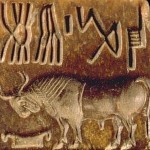 We have all kinds of artifacts engraved with the hieroglyphic script of the Indus Valley civilization, but so far nobody has been able to decipher the language.
We have all kinds of artifacts engraved with the hieroglyphic script of the Indus Valley civilization, but so far nobody has been able to decipher the language.
Researchers from the University of Washington and the Institute of Fundamental Research and Centre for Excellence in Basic Sciences in Mumbai are using computers to find patterns in the placement and order of the hieroglyphics. The patterns can then be extrapolated into a statistical model that reveal the grammatical underpinnings of the language.
“The statistical model provides insights into the underlying grammatical structure of the Indus script,” said lead author Rajesh Rao, a UW associate professor of computer science. “Such a model can be valuable for decipherment, because any meaning ascribed to a symbol must make sense in the context of other symbols that precede or follow it.”
The new study looks for mathematical patterns in the sequence of symbols. Calculations show that the order of symbols is meaningful; taking one symbol from a sequence found on an artifact and changing its position produces a new sequence that has a much lower probability of belonging to the hypothetical language. The authors said the presence of such distinct rules for sequencing symbols provides further support for the group’s previous findings, reported earlier this year in the journal Science, that the unknown script might represent a language.
“These results give us confidence that there is a clear underlying logic in Indus writing,” Vahia said.
The examples of the script we have are just 5 or 6 symbols long, so there’s been some question as to whether it’s a language system at all. The fact that researchers have found syntactical patterns indicates that it is indeed a language and not just a collection of religious or political pictograms.
While the pattern MIGHT represent a language (logically one would assume that it did given the advanced nature of the civilization), I can’t help thinking about how botched my computer’s spell check and grammar check are. Can we really depend on a computer for this kind of thing?
I would think the same faults inherent in spell check or grammar check would prove true for these computers, i.e. being not capable of producing or understanding language that is not say, binary, they seek patterns and order where they do not belong.
I think spell and grammar check rely on a database of specific knowledge (a dictionary of words and a list of grammatical rules). These researchers are using the Markov model, a statistical tool which estimates probability of recurrence of a given symbol based on established patterns.
It’s a whole different ballpark from spell or grammar check.
We are one step nearer to deciphering the Indus Valley script.
You mean referring to this statistical model or do you have new information?
That’s pretty much correct: Spell checker programs are based on the data inside of a database. There is a statistical model available to such a program, because the program tries to place in what it thinks is the correct word, based on the statistical usage of different words.
The word “The” is one of the most commonly-used words, and it is most commonly misspelled “Teh” while typing. A spell-checker program uses both it’s database, and a statistical model to place in what it thinks you most likely meant.
The scenario in the article is a whole different beast altogether, as you have said. The program used for this task, first of all, is necessarily going to be far more sophisticated than a spell-checker on a web browser or in a word processor. Second of all, it isn’t going to rely on a database as it’s primary function. It will primarily calculate patterns, then secondarily, use a statistical model.
A good program for such a task, will have an AI, and the AI will be able to create a statistical model based on those patterns. The biggest obstacle: creating such a program and it’s AI to a certain level of reliability. Not an easy task, and not a very monetarily cheap prospect.